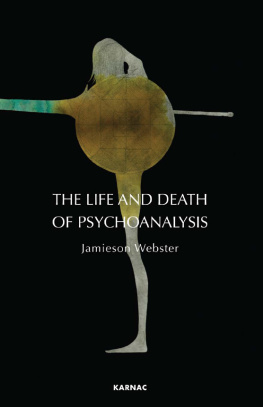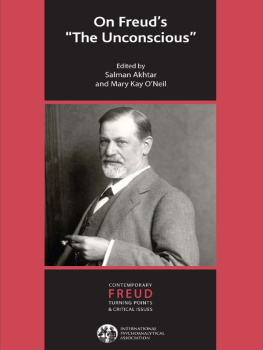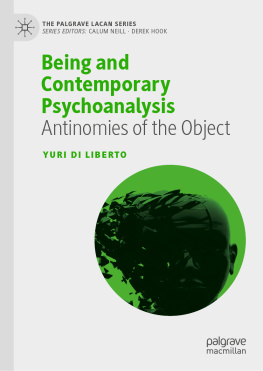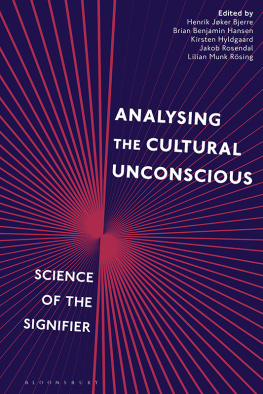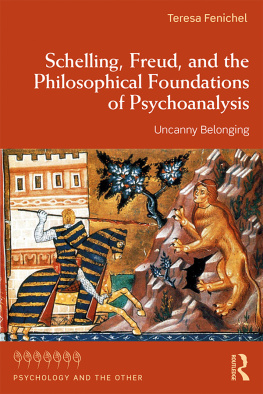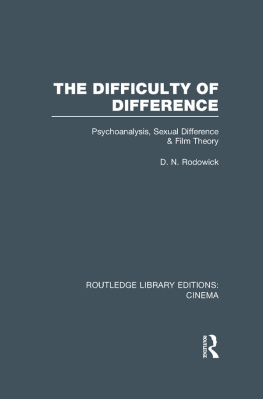PINK HERRINGS
Fantasy, Object Choice, and Sexuation
Damien W. Riggs
KARNAC
First published in 2016 by
Karnac Books Ltd
118 Finchley Road
London NW3 5HT
Copyright 2016 by Damien W. Riggs
The rights of Damien W. Riggs to be identified as the author of this work have been asserted in accordance with 77 and 78 of the Copyright Design and Patents Act 1988.
All rights reserved. No part of this publication may be reproduced, stored in a retrieval system, or transmitted, in any form or by any means, electronic, mechanical, photocopying, recording, or otherwise, without the prior written permission of the publisher.
British Library Cataloguing in Publication Data
A C.I.P. for this book is available from the British Library
ISBN-13: 978-1-78220-174-8
Typeset by V Publishing Solutions Pvt Ltd., Chennai, India
Printed in Great Britain
www.karnacbooks.com
Dedicated to my parents
F M
Sharon Robert
M F
x x x x
CONTENTS
ACKNOWLEDGEMENTS
I begin by acknowledging the sovereignty of the Kaurna people, the First Nations people upon whose land I live and work.
Thanks are due to my classmates and teachers at the Australian Centre for Psychoanalysis, where some of the initial thoughts that led to this book were developed. Special thanks to Julie-Anne Smith, Esther Faye, Leonardo Rodriguez, and Ursula Paton for your words of encouragement, and to the organising committee of the 2012 International Lacan seminar at which Dr. Colette Soler spoke, which was an inspiration for this book.
I owe a considerable debt to my friends who have listened to me talk about this book, and in so doing have helped me to work through my own thoughts about it. Specific thanks go to Louise Messenger, Tom Gross, Stephen Hicks, Amy Patterson, Kate Foord, Alison Ravenscroft, Jess Hondow, and Sophie de Rohan for your insights and support.
It is also important to thank Ian Parker, who believed in this project from our very first correspondence about it, Patricia Gherovici, who inspired me with her own book and who so kindly agreed to write an endorsement for this book, and Chloe Elizabeth, who created the amazing artwork that appears on the cover of this book.
Finally, thanks must go to my children, Gary, Jayden, Liam and Damian, who put up with me spending so many weekends reading and who always remind me of why I do the work I do.
ABOUT THE AUTHOR
Damien W. Riggs is an Associate Professor in social work at Flinders University and an Australian Research Council Future Fellow. He is the author of over 150 publications in the fields of gender/sexuality studies and mental health. He also works in private practice as a Lacanian psychotherapist.
SERIES FOREWORD
This book takes a key concept from the later Lacansexuationand shows that it is crucial to the way we approach sexual difference and gender in Lacanian psychoanalysis; both in the way we track our way back through Lacan's own work, back to the founding texts of that tradition, and in implications for the way we handle transference in the clinic. As a reading, an innovative re-reading of Lacan through the lens of sexuation, the book already accomplishes something seemingly impossible; it shows the reader in a clear accessible way how to make sense of sexuation as a distinctive concept in the Lacanian tradition, as an alternative not only to sexual difference and gender but also to contemporary debates which aim to queer psychoanalysis.
And there is more, for the body of the book is dear to Lacanians and indeed to all psychoanalysts of whatever persuasion, of whatever theoretical or sexual orientation, that is, Freud's own work. A close reading of Freud's case studies rediscovers, as all returns to Freud have attempted to do, the staging of later psychoanalytic concepts elaborated after his death but which now bring his writing alive again. Damien Riggs shows how sexuation is at the heart of Freud's exploration of fantasy and object choice. This is where the clinical implications of this reading take shape in an argument that takes forward not only our understanding of Freud's own clinical practice but our own. We begin to see that the infant's puzzle about the choice made by those who are their first objects will set the coordinates for their own choice, about what they will come to speak about as their own gender and their own sexuality.
Psychoanalytic clinical and theoretical work circulates through multiple intersecting antagonistic symbolic universes. This series opens connections between different cultural sites in which Lacanian work has developed in distinctive ways, in forms of work that question the idea that there could be single correct reading and application. The Lines of the Symbolic series provides a reflexive reworking of psychoanalysis that transmits Lacanian writing from around the world, steering a course between the temptations of a metalanguage and imaginary reduction, between the claim to provide a god's eye view of psychoanalysis and the idea that psychoanalysis must everywhere be the same. And the elaboration of psychoanalysis in the symbolic here grounds its theory and practice in the history and politics of the work in a variety of interventions that touch the real.
Ian Parker
INTRODUCTION
This book began with a titlePink Herrings. At the time I was reading Patricia Gherovici's wonderful book Please Select Your Gender (2010), in which she suggests that the phallus is less a red herring (as Tim Dean, 2000, suggests it to be), and more a read herring. Like gender, Gherovici suggests, the phallus is subject to interpretation, and it will always be read like a text (p. 231). This pun struck a chord with me, and led me to think about how the idea of the read herring might be put to work analytically in the service of ideas that I was grappling with at the time.
In the same year that I read Please Select Your Gender, I was studying at the Australian Centre for Psychoanalysis as part of my formation as an analyst. As would be expected in such a course, we read widely from the works of Freud and Lacan. When it came to reading Freud's (1909d) case study of Paul Lorenzthe Rat ManI was struck by the fact that throughout the case (and in Lacan's later reading of the case) a range of different terms are used to describe the site of the rat torture that constitutes Lorenz's obsession. Admittedly I was reading Strachey's English translation of Freud's writing, but what stood out to me was that in places the site of the torture were the buttocks, in other places the anus. In Miller's (1979) translation of Lacan's account of the torture in The neurotic's individual myth, the word rectum is used.
These differing words used by Freud and Lacan seemed to me to allude to different implications of the torture. If the site of the torture were the buttocks, then the rats would chew their way through the person's body, from back to front. If the site of the torture was more specifically the anus or rectum, then the torture was about the rat entering the person's body as a means of escape. Of course it is far too simple to treat these two modes of torture as mutually exclusive, as I came to see in my own analysis, in which the rat torture became something of a theme.
When I was a child my family and I visited a local tourist destination, where a collection of wax models were displayed in varying states of medieval torture. One of these models was being subjected to the very rat torture described by Lorenz. As a young child I interpreted what I saw as the rats trying to escape the burning coals by chewing their way through the buttocks: from front to back. Arguably this interpretation spoke of growing up in a family where female genitalia were referred to as a front bottom (distinguished from the anus which was referred to as a back bottom). In this sense, and as I suggested above, the binaries of back and front, inside and outside, were perhaps less distinguishable than might at first appear to be, as Lacan's account of the Mobius strip so cleverly demonstrates.




